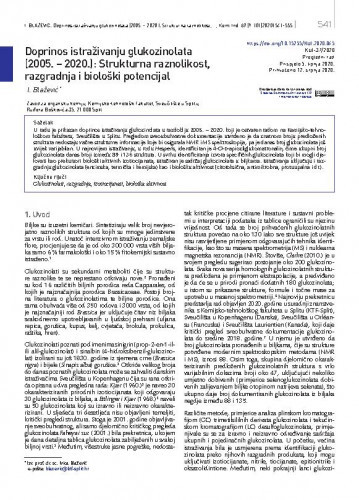U radu je prikazan doprinos istraživanju glukozinolata u razdoblju 2005. – 2020. koji je ostvaren radom na Kemijsko-tehnološkom fakultetu, Sveučilišta u Splitu. Pregledom sveoubuhvatne dokumentacije utvrđeno je da znatnom broju predloženih struktura nedostaju važne strukturne informacije koje bi osigurala NMR i MS spektroskopija, pa je danas broj glukozinolata još uvijek varijabilan. U najnovijem istraživanju, u rodu Hesperis, identificiran je 4-O-D-apiozilglukomatronalin, čime ukupni broj glukozinolata danas broji između 89 i 136 struktura. U svrhu identificiranja izvora specifičnih glukozinolata koji bi mogli djelovati kao prekursori biološki aktivnih izotiocijanata, istraživan je sadržaj glukozinolata u biljkama. Istraživanja uključuju i razgradnju glukozinolata (enzimska, termička i kemijska) kao i biološku aktivnost (citotoksična, antimikrobna, protuupalna i dr.).; This review paper presents a contribution to the research of glucosinolates over the period 2005–2020, which was obtained during work at the Faculty of Chemical Technology, University of Split. After review of the comprehensive documentation, it was determined that a significant number of proposed structures lack important structural information that would be provided by NMR and MS spectroscopy, and today the number of glucosinolates is still variable. In the recent study of Hesperis genus, 4-O-D-apiosylglucomatronalin was identified, which gives the total number of glucosinolates today ranging from 89 to 136 structures. In order to identify the sources of specific glucosinolates that could act as precursors of biologically active isothiocyanates, the content of glucosinolates in plants was investigated. The study also includes the degradation of glucosinolates (enzymatic, thermal, and chemical), as well as biological activity (cytotoxic, antimicrobial, anti-inflammatory, etc.).
Sažetak

 Kemija u industriji : 69,9/10 (2020) / glavni i odgovorni urednik Nenad Bolf.
Kemija u industriji : 69,9/10 (2020) / glavni i odgovorni urednik Nenad Bolf.